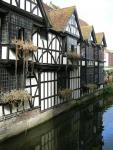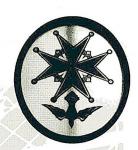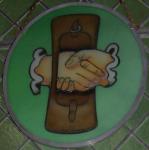Emily Rebecca Morris (1865 - 1936)
THE WALLOON CHURCH IN ENGLAND
The DELASAUX and DUTHOIT families originally came to this country from continental Europe to escape religious persecution there, and the DELASAUX family was certainly amongst the first refugees.
Peter/Pierre DELASAUX the Elder, silk weaver, whose will was proved in 1756, was father to Peter DELASAUX, Gentleman of Canterbury, who in turn was father to Thomas DELASAUX who went on to become alderman and, indeed, mayor of Canterbury. The DELASAUX family was prominent in Canterbury until the 1950s. At the end of Stour Street, approaching St Mildred’s church, was a name plate reading “DELASAUX SQUARE”; it is no longer there, unfortunately. In 1948 Miss Maud DELASAUX was living with her brother Mr C R DELASAUX at 47 St Augustine’s Road; and their father, Mr Robert Augustus, captained St Lawrence Cricket Club for 17 years and at Lord’s in 1858 played for the Gentlemen of Kent against the Gentlemen of England.
In 1561 the then handful of protestant refugees was granted by Elizabeth 1 use of the under-croft of the church of Canterbury Cathedral as a place of worship; they were also granted the right to hold services at St Alphege church, and by the mid 1600s St Peter’s was home to many Walloon and Huguenot refugees.
These early refugees were already highly experienced in ‘the weaving business’ of silk, cotton and wool, and so were well able to support themselves. By 1634 the number of communicants of the Walloon Church in Canterbury alone had increased to 900, and it was estimated that there were between six and seven thousand in the country as a whole, all engaged in the weaving trade. In Canterbury itself the original 25 families had, by the end of the 16th century, increased to some 2,500 inhabitants, between one-half and one-third of the entire population. By 1685 over 1,000 looms were in operation, though the numbers declined rapidly and continued to see-saw. The revocation of the Edict of Nantes in 1685 resulted in a huge increase in Huguenot immigrants, most of whom engaged in the silk trade as distinct from the worsted wool trade of the Walloons. Archbishop Laud made representation to the then King Charles 1 that the Walloons should be required “to conform to the English church”; but just two years later he was inclined to be less dogmatic in view of the orderly behaviour and settled way of life of the Walloon community.
At the start of the reign of Charles 11 in 1665 Walloon numbers had increased to such an extent that the King granted them a charter in 1676 which enabled the 2,500 or so Canterbury members to become a company. When Louis XIV of France in 1685 revoked the Edict of Nantes, which granted freedom of worship to protestants in France, huge numbers fled to sympathetic protestant countries, some 50,000 seeking refuge in Great Britain and Ireland. They brought with them their highly developed manufacturing skills which, apart from weaving, extended to clocks and watches, pottery and precision instruments. Because of the established Walloon Church in Canterbury, many refugees inevitably made their way to that City whose wealth and population rapidly surged.
In recognition of their contribution to the City’s prosperity, a maintenance grant was made available to the poor of the community from 1695 and continued in George I’s reign, albeit much reduced.
Silk weaving largely transferred from Canterbury to Spitalfield in London during the 18th century, but the DELASAUX contingent remained for the most part in Canterbury, Peter DELASAUX and Thomas DELASAUX being listed in 1793 respectively as assistant and warden of the company. The parishes of St Alphege and Northgate were where they tended to live, and they continued to use the undercroft of the Cathedral, the Black Prince’s Chantry, for their place of worship.
Silk production like much else was profoundly affected by the industrial revolution, Arkwright’s machinery for example, and by the American War of Independence. But Canterbury escaped the worst of the downturn in production, and it was a Canterbury manufacturer, John Calloway, who provided the silk furniture for the Prince of Wales’s palace at Carlton House. Hop cultivation, too, did much to enhance the prosperity of Kent and to provide much needed employment. Most of the entire hop production of England was centred around Canterbury and in East Kent, being much favoured by London brewers for strength and consistency.
The Huguenots and Walloons found a haven in this country; they settled and prospered. Industrious manufacturers and merchants, they quickly established themselves as families of substance and began to make a mark in the community. The first generations tended to inter-marry - DELASAUX to BATAILLE, DELASAUX to DUTHOIT; but inevitably, as the migrants integrated into the wider community, conventional ties relaxed and marriages that cut across the separating lines of background and religion became increasingly common. Thus, in the middle of the 18th century, Mary and Ann DELASAUX married, respectively, Peter THORPE and Christopher SIMPSON. A generation later, Elizabeth DELASAUX married Rest FENNER. Nor was this practice confined to daughters who otherwise might not have married: Peter DELASAUX married Elizabeth Gunsley AYERST, daughter of the rector of Canterbury St Peter. A further generation later, Elizabeth DELASAUX married Joseph SIMMONDS, a local brickmaker; and their daughter Mary Ann married William ELLIS who was not born in Canterbury or even in Kent. The Huguenots and Walloons, who came here as refugees from the 16th century on, are but one example of the fertilising immigration which has been such a feature of this country’s history and a principal factor in its political and economic achievement.
In conclusion, therefore, on her father’s side are seven generations of John MORRIS with just one Edward breaking the sequence in the early 18th century; solid Kentish stock living in village parishes like Petham and Waltham.
But Emily’s maternal line goes back a similar number of generations to DELASAUX, DUTHOIT, and BATAILLE; equally solid Huguenot stock living in Canterbury and London, representing the city as MORRIS represents the country.
George Aldis has no personal memories of his maternal grandmother Emily to complement the very affectionate ones he has of his paternal grandmother Alice. So, unless further information becomes available through contact with other descendants of Emily, we will never know the sort of person she was. Married for nearly 50 years, apparently happily, she was the mother of at least seven children, of whom five reached maturity. The present writer knew only two of Emily’s children, his mother Mabel and aunt Millie, these two all too briefly and incompletely. This account by Emily’s grandson is an exploration of her ancestry in an attempt to give her some sort of identity. No photographic evidence has come down to him, and it is unlikely now that any will. So she remains as elusive at the end as she was at the start of this family history research. We have discovered much about you, Emily, through your background; more is the pity that we do not know you better personally.
George Aldis
February 2006









